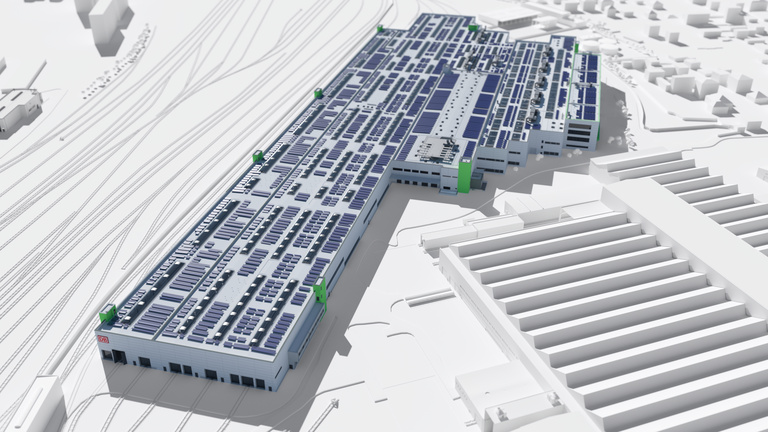Cottbus, Germany, July 30, 2025. In an area previously dominated by lignite mining, German railroad operator Deutsche Bahn (DB) is now building its most advanced repair and maintenance workshop for ICE 4 trains. Two bays with a total of six tracks and one painting line will be available for maintenance of the high-speed trains. Stuttgart-based Drees & Sommer SE specializes in construction, real estate and infrastructure consulting. The company’s team of experts provides advice on project management and cost and schedule controls issues.
Deutsche Bahn wants to invest around twelve billion euros in extending its long-distance rail network by 2030. This will increase its ICE fleet to 450 trains. The delivery of the last completed ICE 4 train, in March 2024, was a milestone on this journey. The trains in the brand-new fleet have to be serviced every 1.65 million kilometers – a distance covered in as little as around three to four years. To ensure that the trains are available to travelers again as quickly as possible, the new workshop was specially designed for this type of ICE train.
Workshop Already Operating at Full Capacity
The project’s first successes are evident in Bay 2. The 445-meter-long bay has been in operation since January 2024, and entire ICE 4 trains can be serviced here on two tracks. This makes time-consuming work such as switching the trains unnecessary. In this bay, staff members are relieved of work thanks to efficient and simplified processes because the use of state-of-the-art technology and automation speeds up maintenance operations.
Completion of Bay 1 is scheduled for 2026: The hall will offer four tracks (with a length of 500 meters and a width of 100 meters) and an automated painting line. Also under construction are a number of ancillary workshops, individual work platforms and an administration and staff social building. One of the special features: the new warehouse benefits from an automated box system in which goods and spare parts will be packed into standardized crates and stacked in a confined space. Several robots will travel across the grid on tracks, retrieve the desired crate at the touch of a button and take it to a work station, saving time and space.
The Rail Partnership Model
Deutsche Bahn is relying on a contract model that is completely new for realizing a complex infrastructure project of this scale. The Rail Partnership Model has been jointly developed by Deutsche Bahn, the Technical University of Berlin (TU Berlin) and the German Construction Confederation (ZDB). The integrated project delivery (IPD) method is characterized by a multi-party contract that is signed by all participating companies. Hence, all project partners are involved at an early stage and together share responsibility for the project. This results in a best-for-project principle: because opportunities and risks are shared equally, all teams pull together. This approach not only encourages collaboration, but it also ensures transparent processes and enables communication between equal partners.
Using Lean Planning to Achieve the Goal Quickly
Planning and implementation of a large-scale infrastructure project have to be learnt – they require precise coordination of schedules and deadlines, quality requirements, staff teams and resources. For example, when specific prefabricated components are delivered too late, the site manager has to act and respond quickly. Drees & Sommer applies lean construction management (LCM) techniques in order to enhance overall transparency and to streamline workflows and coordination processes.
The LCM approach is integrated into all project phases of the construction of the new ICE maintenance and repair workshop in Cottbus, from design and planning through site management to commissioning. Stefan Berger, project manager at Drees & Sommer, explains: “Firstly, we carry out an overall process analysis, and then the strategy and project sequence are planned in detail. Subsequently, we break down the whole construction process into subprojects and allocate the required resources. With the help of defined stability criteria ,we ensure at any time that all deadlines are met. So, all project participants can keep track of the progress of the project.“
Infrastructure Projects Are Becoming More Complex
Efficient processes are needed to manage today’s large-scale infrastructure projects due to their complexity and dynamics. Integrated project management (IPM), in conjunction with lean construction management, helps in keeping an overview of the project at any time: How is the project progressing? Are there any problems? Do we need to change something in our schedule? Drees & Sommer’s team of experts relies on digital planning tools. “LCM Digital enables us to visualize the progress of a project. This overview enables any deviation from the plan to be identified early so that the project can be brought back on course,” says Stefan Berger and adds: “In addition, resources – such as staffing or building materials and equipment – can be managed in a targeted and efficient manner in this way.”
